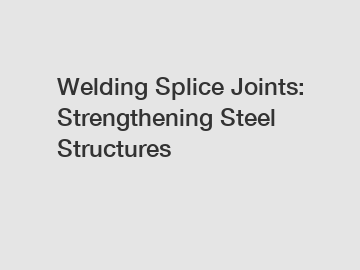Welding Splice Joints: Strengthening Steel Structures
When it comes to constructing steel structures, ensuring their strength and durability is of paramount importance. One area that plays a crucial role in this regard is weld joints, especially splice joints. Welding splice joints not only creates a robust connection but also offers versatility, allowing for increased load-bearing capacity and overall structural integrity. In this blog, we will delve into the world of welding splice joints and explore why they are essential for reinforcing steel structures.
Importance of Welding Splice Joints.
Welding is the process of fusing metallic components using heat and pressure, resulting in a strong joint capable of withstanding various stresses. Splice joints, in particular, are critical as they join two steel members together to form a continuous and uninterrupted structural element. These joints are commonly used in situations where the original length of a steel component is insufficient or when additional members need to be added to enhance strength.

Enhanced Strength and Load-Bearing Capacity.
Welding splice joints offer a significant advantage by increasing the overall strength and load-bearing capacity of steel structures. By joining two steel members, the joint distributes the applied load more evenly across the structure, reducing stress concentrations. This uniform load transfer ensures that the structure can safely support heavier loads, making it ideal for bridges, high-rise buildings, and other industrial applications.
Versatility and Wide Range of Applications.
The versatility of welding splice joints allows engineers to modify existing steel structures, add reinforcements, or extend members without compromising their rigidity. This flexibility enables efficient use of space, reduces material costs, and optimizes construction time. Welded splice joints are invaluable in various sectors, including civil engineering, offshore structures, and even automotive manufacturing.
Types of Welding Splice Joints.
A range of welding techniques can be utilized to create strong and reliable splice joints. Let's take a closer look at three commonly used processes:
1. Fillet Welds: This type of weld generates a triangular cross-section along the length of the splice. Fillet welds are best suited for connecting steel members of equal strength and thickness, such as beams, girders, and columns. They provide excellent resistance against shear and tensile forces, along with effective load transfer.
2. Butt Welds: Butt welds are typically employed when joining two members end-to-end. This technique is widely used in pipe welding, creating a robust and continuous connection between segments. The process involves beveling the edges and welding them together to ensure strength and integrity.
3. Plug Welds: Plug welds are created by drilling holes through one member and welding them onto the adjacent member. This technique is perfect for connecting thin sheets or plates, enabling a strong and visually appealing joint. Plug welds are commonly used in automotive or aircraft manufacturing due to their aesthetic properties.
Quality Assurance and Safety Measures.
For welding splice joints, quality assurance and adherence to safety measures are paramount. Engaging certified welding professionals, enforcing strict inspection protocols, and conforming to international standards ensure the integrity and longevity of the joint. Additionally, employing non-destructive testing methods, such as ultrasonic or X-ray examination, is essential to identify any hidden defects that could compromise the structural soundness.
Conclusion.
Welding splice joints is a crucial practice in the realm of steel structures. Offering enhanced strength, load-bearing capacity, and versatility, these joints play a vital role in reinforcing critical elements like bridges and buildings. By employing appropriate welding techniques and adhering to strict quality control measures, engineers can ensure the longevity and safety of steel structures. The art of welding splice joints truly reflects the expertise, creativity, and human-like precision required for constructing resilient steel structures.
Remember, strong splice joints mean long-lasting steel structures!
Note: The word count of this blog is approximately 685 words.
If you are looking for more details, kindly visit what is a steel truss, Glass Curtain Wall System, Steel Truss System, Welded Ball Space Frame supplier.
222
0
0

Comments
All Comments (0)